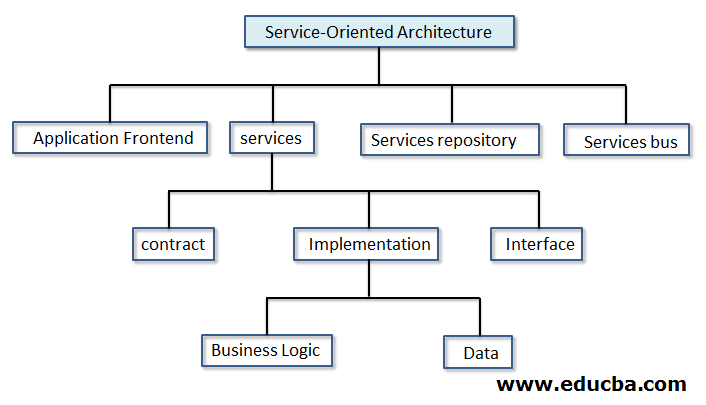Updated April 1, 2023

Introduction to Service-Oriented Architecture
Service Oriented Architecture or SOA architecture is the pattern used in the computer systems to design the software where the application provides services to other applications. This communication is done with the help of a protocol, and it happens through a network. This does not have any orientation over any technology or a product in the system. This is an example of distributed architectural computing in the network. This can be implemented with the help of Java or .Net, and the application can be in a different language. This allows the inbuilt functions to run by itself.
Explanation of SOA architecture:
SOA has an application frontend, service, repository and service bus in the front end. Application front end receives input from the users and deposits it into the service repository. Service takes the input from the depository and pass it onto an interface. There are interface, implementation and contract in the second stage. The inputs are implemented for the requirement and checked for business logic and data. This result is passed through implementation to the interface and finally to the frontend of the service. Hence SOA works to satisfy the requirements with the help of services in the architecture.
Components of SOA architecture
Below are the components of SOA Architecture:
1. Different layers in SOA are the consumer interface layer, business process layer, services layer, service component layer and operational systems layer. The consumer interface layer interacts with the user and has the user interface. All the business applications are stored in the business process layer. All the services are run in the services layer. Functional and technical applications are saved in-service component layer. The operational systems layer has the data model in the system.
2. Services in the architecture helps to process the raw materials from the user and pass the information to the next layer for the proper implementation of the service.
3. Process layer is important in the architecture to do the managing of different parts in SOA. New services and applications are managed with the help of services in different forms. The processes are automated in this layer, and the services are made into a manageable process.
4. A framework is used in the architecture which binds the user interface and business logic together. This is written in Java or .Net language and helps the applications to finds their pace in the architecture and to perform well. There is a coupling between the front end and the services to make it work so that new applications can be developed here.
5. All the processes in the architecture are constantly monitored for their performance, the state, the process they do and the speed at which the process is performed. This may create a problem in between, and in order to manage this, Business Activity Monitoring is enabled in the system. With this, a report can be created and a dashboard to know the process. This provides proper visibility to the entire system and the processes in the SOA.
6. There is an Operational Data Store in SOA to provide all the data, synchronised and synchronized, to view it from the customer perspective. Also, this helps to know the business in the long run. Customer purchases, store lists, product lists, backend services could be accessed from Access services, but ODS is a more formal way to get ordered data. This helps to transfer data from one service to another and also to know all the instance of the data.
7. Business Intelligence in SOA helps to report the instances of data services in ODS if it happens frequently and to note down the attacks to the system for the data. Data architecture may get broken down in between, and it is hard to make it back to the proper architecture. So, Business Intelligence helps in these instances to know the access provided to the users and the data availability for each access provider in the system. This also allows for the end-user reporting availability in the system.
8. Security for the architecture is uncompromised due to the data it carries. Most of the time, due to the service requests, security has to be neglected to transfer the data and to access the needed services. Security is provided in almost all the components in the architecture so that proper data is provided about the data accesses in the system.
9. Management in SOA is very important due to the components in the architecture being loosely arranged in the structure. If not, the performance of the services will be very poor and cannot be managed by the programmers alone. Hence, there are operators in the architecture to monitor the system status and performance, and if there are any potential threats, it is their responsibility to warn the authorities regarding the same.
Benefits of SOA Architecture
Below are the benefits of SOA Architecture:
- Even though the services in the architecture uses different languages, all the services are integrated through a neutral language mechanism in SOA. This neutralization of languages is one important advantage in the architecture.
- If the application is built once up and running, the entire organization can be benefitted from the service and use the applications in all the other applications. The components can be reused and migrated to any other language for the better performance of the architecture.
- The components in the service can be reused and recombined for the cost and time-saving in the organization. This helps to perform tasks easily in the services. Also, agile tasks can be performed easily. It integrates with other applications to perform to the system’s or application’s needs.
- The existing system or application can be upgraded so that the architecture offers its benefits to the service. Functions of the applications and the architecture can be combined so that they can be made available to the entire organization or the enterprise.
Cloud computing can be integrated into SOA, which integrates its services more and is more helpful to the users. Many networks can be combined in the architecture, and the messages can be integrated to be used in different services. This helps for proper communication in the system.
Recommended Articles
This is a guide to SOA Architecture. Here we also discuss the Introduction to SOA Architecture and its top Components along with advanced benefits. You may also have a look at the following articles to learn more –


